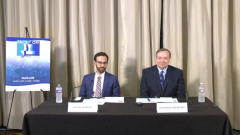
Cross Q&A: Isa + KD in Relapsed/Refractory MM and Biochemical vs Clinical Progression
In the final cross Q&A session from the multiple myeloma module, panelists discuss implications of IKEMA and consider the importance of biochemical versus clinical progression.
Episodes in this series

Transcript:
Judy Schreiber, PhD, RN: Any questions from Texas back to us here in Minnesota?
Adeel Khan, MD, MPH, MS: Sure. I’ll ask a question about this presentation first, and then I have one of your earlier one. Wonderful presentation, Dr Gonsalves. With all the limitations noted of retrospective data, this shows what one would anticipate that clinical progression is quote, unquote, worse than biochemical progression. How do you see this now fitting in the landscape where MRD [minimal residual disease] testing is all the rage and we’re starting to use that more prevalently [and considering] mass [spectrometry] has also come into the picture? We’re discussing the 10 to the –5 vs the 10 to the –6. How do you see that fitting into some of these data?
Wilson Gonsalves, MD: I agree, so I’ll start off by saying, I don’t think this data come close to answering any of those questions. Because first, it was 2001 to 2018, so half of those concepts didn’t even exist back in about half of the population. From a practical standpoint, and I’ll be curious to see how you’ll do it at UT Southwestern, I see a patient, they get induction therapy, let’s just say they go to transplant, they are on maintenance therapy, and that’s the patient population we’re watching. I don’t necessarily check MRD testing routinely in patients who I think are on maintenance and are doing fine from whatever testing I have in terms of the paraproteins in the blood; we use mass fixation a lot, and that’s probably one thing that can apply here. I don’t do bone marrow biopsies, I don’t particularly even with the high risk or standard risk, and I know in the myeloma field, people have different opinions on that, but what would be interesting to note is, if you’re going to use that, it must be done in a prospective controlled fashion like, for example, if I were to hypothesize, maybe those ultra-high-risk patients were MRD negative, and let’s just say everyone’s checking MRD negativity, and those patients are the ones who are showing early loss of their MRD-negative status on there, would it benefit them to jump on treatment earlier and avoid various morbid complications? I don’t know that for sure, and I think the only way you could answer that is in a prospective controlled trial, but my gut feeling would be I would be a little worried about those patients per se. Clearly, we have plenty of patients who are biochemically progressing very slowly, and you can probably gain another 8 to 12 months just watching them slowly biochemically progress. That probably beats half the PFS [progression-free survival] as reported in these abstracts over here just by that. That’s how I think if we’re going to answer that question [it] would probably have to be done prospectively because there are just too many nuances. Clinicians are very astute, and they can see the patient, and their decision right now on who they need to start treating early and who can be watched is something that it’s hard to grasp that with a blood test or so on. Sorry, long answer to a probably simple question.
Judy Schreiber, PhD, RN: Question on IKEMA.
Adeel Khan, MD, MPH, MS: The [phase 3] IKEMA [NCT03275285] data is fascinating, and I can’t help but make the comparison to [the phase 3] CANDOR [trial (NCT03158688)]; there’s always these issues of trying to make mental cross-trial comparisons. In CANDOR where Dara-Kd [daratumumab plus carfilzomib and dexamethasone] was compared to Kd, and now those two IKEMA Isa-Kd [isatuximab plus Kd] vs Kd. In CANDOR at least we saw that the PFS, and while I should back up and say that it’s a toxicology in trying to find a role with respect to where does it fit in this the CD38 monoclonal antibody space with dara having so much of the market, we saw that in CANDOR if we compare the comparators, the Kd vs Kd, the PFS was something like 15 months in CANDOR vs IKEMA was about 19 to 20 months. Does that motivate you one way or the other to think of Isa-Kd vs Dara-Kd differently?
Wilson Gonsalves, MD: Looking at the data, and as I was trying to make the slide, so it’s going back and looking at CANDOR, you’re absolutely right. The PFS of the control arm is about 5, 6 months higher in the IKEMA trial than the CANDOR trial. So even numerically, the PFS looks a little better in the IKd vs the DKd, but I don’t know if the patient population in itself is just a bit different in there. They both had roughly about a third of the patients [who] were [lenalidomide] refractory on there. The part that I would look at both of those and say the hazard ratios tend to be at least a good 0.1 to 0.2 better in the CANDOR studies than IKEMA. But I’m not entirely sure, again; cross-trials comparisons, we’re always told never to compare them. I don’t know whether [I] would truly use that in my practice. What dictates my practice right now is what’s practical for the patient. I think dara has a leg up with the sub-q version. It’s interesting with DKd and IKd, you can argue and say they’re going to get IV [intravenous] carfilzomib no matter what, so it isn’t that big of a deal getting the isatuximab IV, so maybe that could be a population where there’s some and patients don’t necessarily feel strongly about getting DKd vs IKd, but I have a hard time using one or the other to justify which one I’m going to use. Probably in the community and everywhere else, we have some sort of bias already for using dara for so long and in its sub-q formulation that I would imagine practice patterns in the country would probably point to dara being used, being more likely to be combined with carfilzomib than isatuximab. I don’t know where it will find a home, but clearly, they’re working on a subcutaneous version, where at least they reported on some possible trials on this. We’ll see where the chips eventually lay, but I don’t think anything in both studies make me feel one way or the other strongly.
Larry Anderson Jr, MD, PhD, FACP: A couple questions, or at least a question. So excellent presentation; along that same line, how do you choose between which CD38, which, not necessarily, and you have given a true answer to that, but then let’s just say you have a patient who’s relapsing, and quite impressive data with both IKEMA and CANDOR. How do you choose a proteasome inhibitor CD38 vs an IMiD [immunomodulatory imide drug] and a CD38? Do you have particular go-to patients that you’d recommend this, for example, high-risk patients? Do you buy into the chromosome 1 affecting the complement cascade and making one CD38 more effective than another? Those kinds of things.
Wilson Gonsalves, MD: That’s a great question. I think it’s a great point, and there’s been a slew of papers coming out pointing toward isatuximab and maybe its leg up in that one q-abnormality population. Again, these are, I don’t think necessary prespecified type assessments. I don’t know how significant these results are. I haven’t necessarily based my decision on using isatuximab on just that, if you’re 1q you should be getting isatuximab base therapy vs Dara-Kd when something has not been planned ahead of time to decide. If one did have to pick one or the other, I feel like patient preference and patient [adherence] and how I think the ease of getting once-every-four-weeks dara eventually vs every-two-week isatuximab does factor in that role in terms of picking. As far as, do you dare [use] a CD38 antibody vs an IMiD vs a proteasome inhibitor in somebody with first-line relapses? Let’s say they’re progressing on [lenalidomide] maintenance or so on there. If you’re not supposed to do cross-trial comparisons, but one would look at those numbers and those hazard ratios and probably say maybe it would point to that the combination of the Kyprolis [carfilzomib] with the CD38 antibody may look better, with all the caveats that come with cross-trial comparisons, but I’ve followed more for practical approach of saying, if somebody’s progressing on an IMiD-like therapy and are refractory to lenalidomide on there, maybe I want to switch the class of that itself and do more for CD38 and partnered with the proteasome inhibitor, especially if they haven’t seen one in a while.
Larry Anderson Jr, MD, PhD, FACP: Great. Excellent. What about now, and going with your other data with the kind of indolent or biochemical progression vs clinical progression, do you use that in your practice to decide, I’m more likely to recommend, for example, an oral regimen, and not make them come in and use up their best lines of therapy options right away, or do you typically observe those biochemical progressions if they’re not rapidly rising?
Wilson Gonsalves, MD: I guess that’s an individualized question, and I can paint different scenarios, and they may still not encompass all the different scenarios patients present with. Clearly plain biochemical progressions like, for example, if we use MASS-FIX here as a staple. So [for] somebody just turning MASS-FIX positive on therapy, I’m not entirely inclined to jump and change therapy; I’m more inclined to continue to closely monitor things. My first thought whenever somebody’s progressing, is there a clinical trial? And the reality is no clinical trial is going to take you in with an M spike of 0.1 or a MASS-FIX positive; you likely need an M spike of 0.5 or higher, so that automatically makes life easier. Even when you’re thinking practically on who to treat, when to treat, and how to treat, I don’t necessarily use the concept of OK, this regimen is not that great, so let’s use it up first because I’ll save it for later. I believe that if there are truly data for using the best regimen in that first relapse, then that’s what should be done, rather than changing the natural history of the biology, and then you don’t know whether your best therapy is the best therapy at that point as promised earlier. The people I am worried about are clearly the clinical progressors, like folks who presented with bad cast nephropathy, and then you can make some clinical judgments of this cast nephropathy with light chains of only like 100 or 200 mg, so I say I’m not going to let them get to that level. Again, that’s more of a nuanced thing that we talk to the patient about, and clearly, I don’t have data or nobody has data to say this is the optimal time that you should start therapy and you get the best of both worlds; you observe them for a longer period of time, and you avoided them having that CRAB features [hypercalcemia, renal dysfunction, anemia and bone lesions] on, so a little bit of is based on how they present with. But that is the group that I’d be more worried about if they truly had bad clinical symptoms and diagnosis that like cast nephropathy or even the plasma cell leukemia, when they proliferate, and they have phases, so when they relapse they can take off pretty quickly, so maybe [with] those ones you’re being more aggressive in terms of taking them off and not just watching.
Transcript edited for clarity.
Newsletter
Stay up to date on recent advances in the multidisciplinary approach to cancer.



















































































